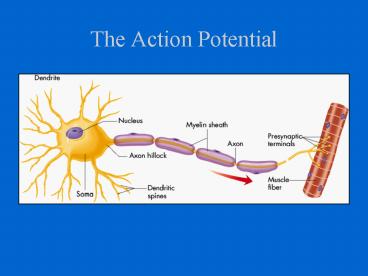The Action Potential - PowerPoint PPT Presentation
1 / 18
Title:
The Action Potential
Description:
Absolute Refractory Period. Sodium gates are firmly closed ... Relative Refractory Period. Sodium gates in usual state, but the potassium gates remain open. ... – PowerPoint PPT presentation
Number of Views:582
Avg rating:3.0/5.0
Title: The Action Potential
1
The Action Potential
2
- The Resting Potential of the Neuron
- results from difference in ion distribution
inside and outside of cell (-70mV)
3
(No Transcript)
4
- Forces Behind Resting Potential
- Selective Permeability- some molecules pass
through membrane more freely than others ion
channels - Sodium-Potassium Pump- transports 3 Na
out of, 2 K into cell - Result
- Concentration Gradient
- Electrical Gradient
5
(No Transcript)
6
(No Transcript)
7
- Forces Behind Resting Potential
- What would you do to generate electrical signal
fast? - RP takes work (Na/K Pump). Why do we bother?
8
Molecular Basis of Action Potential
- Sodium channels open once threshold is reached,
influx of sodium - Potassium channels open at AP peak potassium
flows out
9
(No Transcript)
10
http//faculty.washington.edu/chudler/ap.html
http//www.blackwellscience.com/matthews/channel.
html
11
- The All-or-None Law
- The size, amplitude, and velocity of an action
potential are independent of the intensity of the
stimulus that initiated it. - How then is stimulus intensity coded?
12
(No Transcript)
13
Figure 2.20 Saltatory conduction in a myelinated
axonAn action potential at the node triggers
flow of current to the next node, where the
membrane regenerates the action potential.
14
The Action Potential
- The RefractoryPeriod
- Absolute Refractory Period
- Sodium gates are firmly closed
- Membrane cannot produce AP, regardless of the
stimulation. - Relative Refractory Period
- Sodium gates in usual state, but the potassium
gates remain open. - Stronger than normal stimulus needed for action
potential.
15
Propagation of the Action Potential
- From Axon Hillock
- To Terminal Buttons
- AP travels in one direction only. WHY?
16
The Myelin Sheath and Saltatory Conduction
- Myelin Sheaths increase the speed of neural
transmission - Nodes of Ranvier-Short areas of the axon that
are unmyelinated - Saltatory Conduction-jumping action of actions
potentials from node of Ranvier to node of Ranvier
17
(No Transcript)
18
Signaling Without Action Potentials
Depolarizations and hyperpolarizations of
dendrites and cell bodies Small Local
neurons-produce graded potentials (membrane
potentials that vary in magnitude and do not
follow the all-or-none law)































